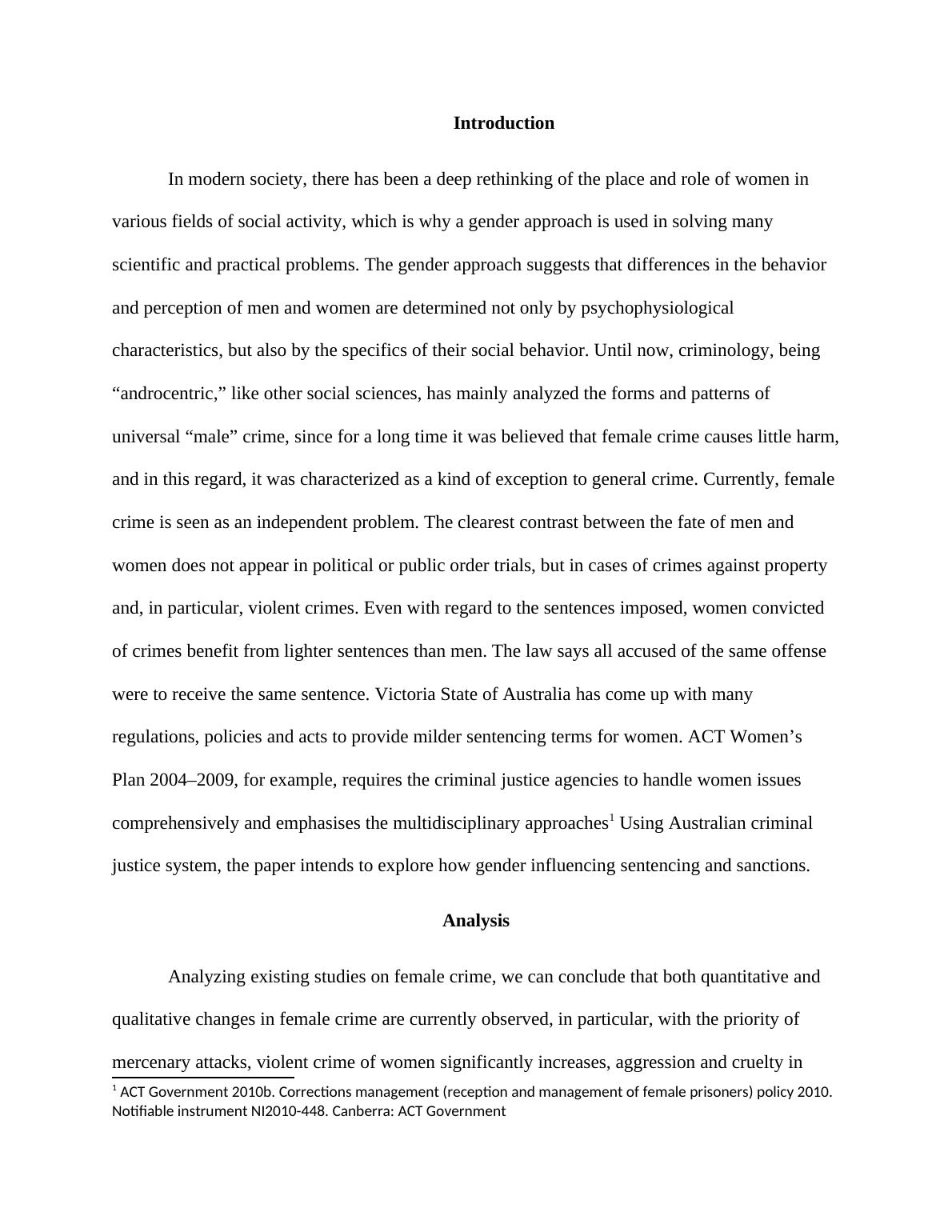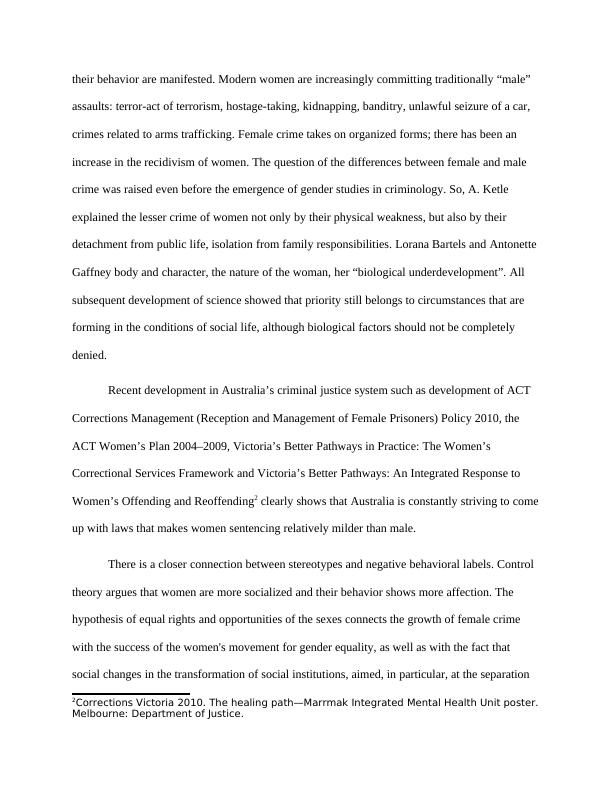Assignment on Sentencing Disparities and Gender
14 Pages3695 Words14 Views
Added on 2022-08-20
Assignment on Sentencing Disparities and Gender
Added on 2022-08-20
ShareRelated Documents
Sentencing Disparities and Gender
Student’s Name
Institution
Date
Student’s Name
Institution
Date

Introduction
In modern society, there has been a deep rethinking of the place and role of women in
various fields of social activity, which is why a gender approach is used in solving many
scientific and practical problems. The gender approach suggests that differences in the behavior
and perception of men and women are determined not only by psychophysiological
characteristics, but also by the specifics of their social behavior. Until now, criminology, being
“androcentric,” like other social sciences, has mainly analyzed the forms and patterns of
universal “male” crime, since for a long time it was believed that female crime causes little harm,
and in this regard, it was characterized as a kind of exception to general crime. Currently, female
crime is seen as an independent problem. The clearest contrast between the fate of men and
women does not appear in political or public order trials, but in cases of crimes against property
and, in particular, violent crimes. Even with regard to the sentences imposed, women convicted
of crimes benefit from lighter sentences than men. The law says all accused of the same offense
were to receive the same sentence. Victoria State of Australia has come up with many
regulations, policies and acts to provide milder sentencing terms for women. ACT Women’s
Plan 2004–2009, for example, requires the criminal justice agencies to handle women issues
comprehensively and emphasises the multidisciplinary approaches1 Using Australian criminal
justice system, the paper intends to explore how gender influencing sentencing and sanctions.
Analysis
Analyzing existing studies on female crime, we can conclude that both quantitative and
qualitative changes in female crime are currently observed, in particular, with the priority of
mercenary attacks, violent crime of women significantly increases, aggression and cruelty in
1 ACT Government 2010b. Corrections management (reception and management of female
prisoners) policy 2010. Notifiable instrument NI2010-448. Canberra: ACT Government
In modern society, there has been a deep rethinking of the place and role of women in
various fields of social activity, which is why a gender approach is used in solving many
scientific and practical problems. The gender approach suggests that differences in the behavior
and perception of men and women are determined not only by psychophysiological
characteristics, but also by the specifics of their social behavior. Until now, criminology, being
“androcentric,” like other social sciences, has mainly analyzed the forms and patterns of
universal “male” crime, since for a long time it was believed that female crime causes little harm,
and in this regard, it was characterized as a kind of exception to general crime. Currently, female
crime is seen as an independent problem. The clearest contrast between the fate of men and
women does not appear in political or public order trials, but in cases of crimes against property
and, in particular, violent crimes. Even with regard to the sentences imposed, women convicted
of crimes benefit from lighter sentences than men. The law says all accused of the same offense
were to receive the same sentence. Victoria State of Australia has come up with many
regulations, policies and acts to provide milder sentencing terms for women. ACT Women’s
Plan 2004–2009, for example, requires the criminal justice agencies to handle women issues
comprehensively and emphasises the multidisciplinary approaches1 Using Australian criminal
justice system, the paper intends to explore how gender influencing sentencing and sanctions.
Analysis
Analyzing existing studies on female crime, we can conclude that both quantitative and
qualitative changes in female crime are currently observed, in particular, with the priority of
mercenary attacks, violent crime of women significantly increases, aggression and cruelty in
1 ACT Government 2010b. Corrections management (reception and management of female
prisoners) policy 2010. Notifiable instrument NI2010-448. Canberra: ACT Government

their behavior are manifested. Modern women are increasingly committing traditionally “male”
assaults: terror-act of terrorism, hostage-taking, kidnapping, banditry, unlawful seizure of a car,
crimes related to arms trafficking. Female crime takes on organized forms; there has been an
increase in the recidivism of women. The question of the differences between female and male
crime was raised even before the emergence of gender studies in criminology. So, A. Ketle
explained the lesser crime of women not only by their physical weakness, but also by their
detachment from public life, isolation from family responsibilities. Lorana Bartels and Antonette
Gaffney body and character, the nature of the woman, her “biological underdevelopment”. All
subsequent development of science showed that priority still belongs to circumstances that are
forming in the conditions of social life, although biological factors should not be completely
denied.
Recent development in Australia’s criminal justice system such as development of ACT
Corrections Management (Reception and Management of Female Prisoners) Policy 2010, the
ACT Women’s Plan 2004–2009, Victoria’s Better Pathways in Practice: The Women’s
Correctional Services Framework and Victoria’s Better Pathways: An Integrated Response to
Women’s Offending and Reoffending2 clearly shows that Australia is constantly striving to come
up with laws that makes women sentencing relatively milder than male.
There is a closer connection between stereotypes and negative behavioral labels. Control
theory argues that women are more socialized and their behavior shows more affection. The
hypothesis of equal rights and opportunities of the sexes connects the growth of female crime
with the success of the women's movement for gender equality, as well as with the fact that
social changes in the transformation of social institutions, aimed, in particular, at the separation
2Corrections Victoria 2010. The healing path—Marrmak Integrated Mental Health Unit poster.
Melbourne: Department of Justice.
assaults: terror-act of terrorism, hostage-taking, kidnapping, banditry, unlawful seizure of a car,
crimes related to arms trafficking. Female crime takes on organized forms; there has been an
increase in the recidivism of women. The question of the differences between female and male
crime was raised even before the emergence of gender studies in criminology. So, A. Ketle
explained the lesser crime of women not only by their physical weakness, but also by their
detachment from public life, isolation from family responsibilities. Lorana Bartels and Antonette
Gaffney body and character, the nature of the woman, her “biological underdevelopment”. All
subsequent development of science showed that priority still belongs to circumstances that are
forming in the conditions of social life, although biological factors should not be completely
denied.
Recent development in Australia’s criminal justice system such as development of ACT
Corrections Management (Reception and Management of Female Prisoners) Policy 2010, the
ACT Women’s Plan 2004–2009, Victoria’s Better Pathways in Practice: The Women’s
Correctional Services Framework and Victoria’s Better Pathways: An Integrated Response to
Women’s Offending and Reoffending2 clearly shows that Australia is constantly striving to come
up with laws that makes women sentencing relatively milder than male.
There is a closer connection between stereotypes and negative behavioral labels. Control
theory argues that women are more socialized and their behavior shows more affection. The
hypothesis of equal rights and opportunities of the sexes connects the growth of female crime
with the success of the women's movement for gender equality, as well as with the fact that
social changes in the transformation of social institutions, aimed, in particular, at the separation
2Corrections Victoria 2010. The healing path—Marrmak Integrated Mental Health Unit poster.
Melbourne: Department of Justice.

of the main social institutions (for example, marriage, education, employment ), gave rise to a
more accessible opportunity for women to participate in criminal activities. Recently, there have
been developments according to which differences in gender roles can explain the existence of a
gender gap in crime rates, the traditional female role is incompatible with criminal behavior, and
masculine self-identification should increase the likelihood of delinquency, while feminine
should decrease The main merit of multiple gender studies of crime can be considered the use of
the data obtained in the development of programs for female offenders. Thus, some jurors surely
judged women more severely than men, while others based their verdicts on an evaluation of the
evidence without taking into account the sex of the accused3.
Victoria’s Better Pathways in Practice: The Women’s Correctional Services Framework
(Corrections Victoria 2007) advocate for gender responsive correctional services. Besides, of
course, the weight of the evidence, one may wonder why the jurors applied the law in all its rigor
to some women and not to others. More research on the criminal courts is needed to more surely
tackle this question which will always remain, fundamentally, elusive. But among the elements
likely to have influenced the juries, one can cite more particularly the physical and dress
appearance of the accused, their poverty, the perception by the jurors of their supposed excessive
or immoral sexuality, their status (married or single woman) . Some of these characteristics are
elusive and are part of the essential mystery of the courtroom. Thus, the external appearance of
the accused must have played a role in criminal trials. Here, as on other scenes. In the courtroom,
the question of the appearance of the accused certainly added to the question of her
"respectability"4.
3 Lorana Bartels and Antonette Gaffney. Good practice in women’s prisons: A literature
review. (Australian Institute of Criminology 2011)
4 Corrections Victoria 2009a. Statistical profile of the Victorian prison system 2004–05 to
2008–09. Melbourne: Department of Justice
more accessible opportunity for women to participate in criminal activities. Recently, there have
been developments according to which differences in gender roles can explain the existence of a
gender gap in crime rates, the traditional female role is incompatible with criminal behavior, and
masculine self-identification should increase the likelihood of delinquency, while feminine
should decrease The main merit of multiple gender studies of crime can be considered the use of
the data obtained in the development of programs for female offenders. Thus, some jurors surely
judged women more severely than men, while others based their verdicts on an evaluation of the
evidence without taking into account the sex of the accused3.
Victoria’s Better Pathways in Practice: The Women’s Correctional Services Framework
(Corrections Victoria 2007) advocate for gender responsive correctional services. Besides, of
course, the weight of the evidence, one may wonder why the jurors applied the law in all its rigor
to some women and not to others. More research on the criminal courts is needed to more surely
tackle this question which will always remain, fundamentally, elusive. But among the elements
likely to have influenced the juries, one can cite more particularly the physical and dress
appearance of the accused, their poverty, the perception by the jurors of their supposed excessive
or immoral sexuality, their status (married or single woman) . Some of these characteristics are
elusive and are part of the essential mystery of the courtroom. Thus, the external appearance of
the accused must have played a role in criminal trials. Here, as on other scenes. In the courtroom,
the question of the appearance of the accused certainly added to the question of her
"respectability"4.
3 Lorana Bartels and Antonette Gaffney. Good practice in women’s prisons: A literature
review. (Australian Institute of Criminology 2011)
4 Corrections Victoria 2009a. Statistical profile of the Victorian prison system 2004–05 to
2008–09. Melbourne: Department of Justice

End of preview
Want to access all the pages? Upload your documents or become a member.
Related Documents
Women in Prison in Australialg...
|13
|4370
|461
Why Messerschmidt rejects Jefferson's thesis on a male criminal behaviour analysislg...
|2
|723
|204
Gender Difference In Crime Analysis And Court Outcomeslg...
|13
|2828
|401
Race, Class and Gender in Criminologylg...
|3
|611
|307
CRI30001: Advanced Topics in Criminology Assignmentlg...
|5
|938
|34
Incarcerated Men and Women: Privilege, Inequality, and Feminismlg...
|4
|792
|187
